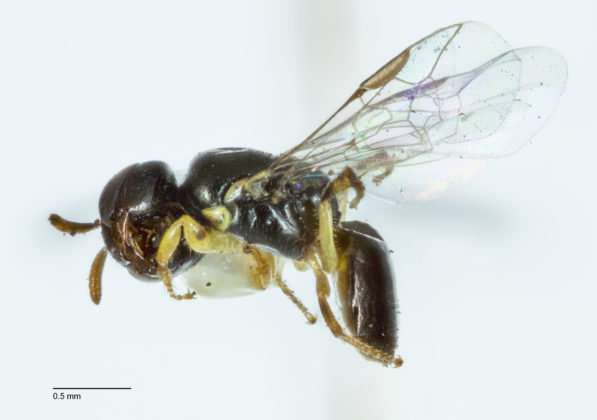Study finds tiny cavities in Banksia trees are nests for native bees

A new study from Curtin University has found pre-formed cavities in Banksia trees to be an important nesting home for a tiny native Western Australian bee.
The study, published in the international open-access Journal of Melittology, observed the nesting behaviour of Euryglossina perpusilla (E.purpusilla) in Star Swamp Reserve, a 96-hectare A-class reserve in North Beach, located in Perth's northern suburbs.
Author, Ph.D. student Kit Prendergast, from Curtin's School of Molecular and Life Sciences, said little was known about the nesting habits of Euryglossina bees.
"Most native bee sub-families are known to nest in just one type of substrate, being wood nesters, or ground nesters. However, the sub-family Euryglossinae exhibits a range of sociality in nesting habitats and nest construction," Ms Prendergast said.
"They appear to use a range of materials to create their nests in, including the inside of stems, soft wood, pre-existing cavities and soil."
Ms Prendergast installed trap-nests, or bee hotels – wooden blocks with cardboard lined holes 4mm, 7mm and 10mm in diameter – to observe the nesting behaviour of cavity-nesting native bees. Although many native bee species in the Megachilidae family nested in the trap-nests, E. purpusilla never occupied them, instead choosing smaller natural cavities of 1.5 to 3mm in diameter in Banksia branches. However, a small Megachile species was observed to also share the Banksia holes with E. purpusilla.
Ms Prendergast said the study offered important insights that may protect the survival of E. purpusilla, as effective conservation required knowledge of a species' niche and interactions with its environment.
"There is an urgent need to increase our knowledge of Australian native bees given the rapid transformation of natural habitats by urbanisation and reports of bee declines across the globe," Ms Prendergast said.
"With much of the original Banksia woodland destroyed in the southwest Australian biodiversity hotspot, remnant bushland habitats such as Star Swamp Reserve may be fundamental to ensuring endemic species such as these native bees persist."
Euryglossinae is the most species-rich bee sub-family in Australia, with 404 named species comprising minute to small-bodied bees endemic to Australia.
More information: Kit Stasia Prendergast. Euryglossina (Euryglossina) perpusilla (Hymenoptera: Colletidae: Euryglossinae) nesting in pre-formed cavities in Banksia attenuata (Proteaceae), Journal of Melittology (2018). DOI: 10.17161/jom.v0i81.6936
Provided by Curtin University



















